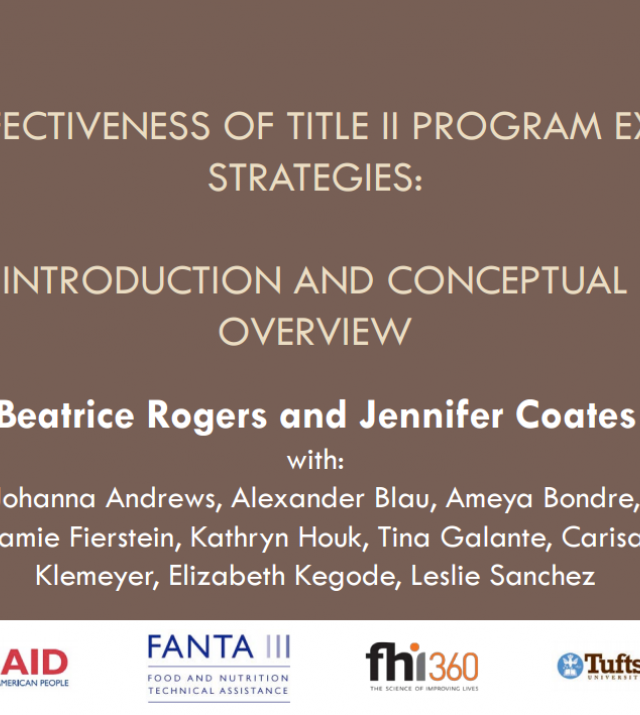
Exit Strategies: A Review of Promising Practices in Title II Implementation
Presenter: Beatrice Rogers, Professor of Economics and Food Policy; Director, Food Policy and Applied Nutrition Program, Friedman School of Nutrition Science and Policy, Tufts University
A persistent challenge in food aid programming is to ensure that the benefits of these programs continue after the food is withdrawn and the programs shut down. Tufts University, with support from USAID through the Food and Nutrition Technical Assistance III Project, has been conducting a multi-country study of how programs can be designed, and the process of program exit structured, to improve the likelihood of the continuation of the program’s activities and positive impacts after exit.
The study is looking at four key factors that contribute to sustainability: resources, capacity, motivation and linkages. Several examples of success within these factors were shared, such as a project focused on giving people skills (“capacity”) that the community values so that they are willing to contribute “resources” in order to sustain the activity. An example of a water and sanitation project was given where technicians were trained to do maintenance for a water project. People valued this service and were willing to pay for the skills so the water project had a maintenance plan for repairs built in. Another example looked at “linkages” where the capacity in the government was available. Establishing vertical linkages was helpful. For example, in Kenya, animal health workers were trained and the Kenya Ministry of Health took on future training of these health workers.
The study has demonstrated the importance of designing for sustainability from the start of a program: partnership formation and capacity building, along with demand creation, leads to independent operation of services and systems. Other sustainability processes – including the importance of gradual withdrawal over time so that capacity is transferred to the community during a period of continued project support. The importance of establishing explicit benchmarks for exit strategies was also emphasized.
Participants noted that, among the four factors, “resources” is often one of the key challenges and can be related to maintaining key activities, but also relevant to the eventual need for updating skills or training additional community members over time. Participants also noted that vertical and horizontal linkages can help meet these needs. Participants also discussed multiple ways in which the factor of “motivation” can be addressed.
The Way Forward: Participants made recommendations in the following areas:
Knowledge Sharing
Establish a working group to discuss issues related to exit strategies and sustainability of programs. There may be advantages to regionally focused groups.
More cross-sectoral workshops like this! Nutrition outcomes are very dependent on other sectors so more information sharing is needed to better integrate, think about targeting differences among beneficiaries in the same project, etc.
Program Design
For health and nutrition, integration with some sort of savings and lending, or agro-enterprise would seem to be key to increase sustainability. There has to be some point at which additional household resources are generated to cover ongoing costs.
Research and Evidence Base
USAID should fund additional retrospective studies, where the key elements of exit strategies were properly incorporated in planning. Because sustainability is very context-dependent, studies need to be funded in several countries, but results shared across the humanitarian community.
A study should focus on a combination of interventions (a graduated package of interventions) and how they leverage each other on the four attributes critical for exit strategies.
Donor Policy and Practice
Clear exit strategies must be requested in the RFA in order that they’ll be addressed from the design stage. Programs incorporating sound exit strategies should be viewed favorably at the funding stage.
RFAs could specify allocating funding for return trips to assess sustainability as a standard part of programs from proposal stage (E.g. for each 5 year program, allocate $30,000 for an evaluation team to go back in year 7).